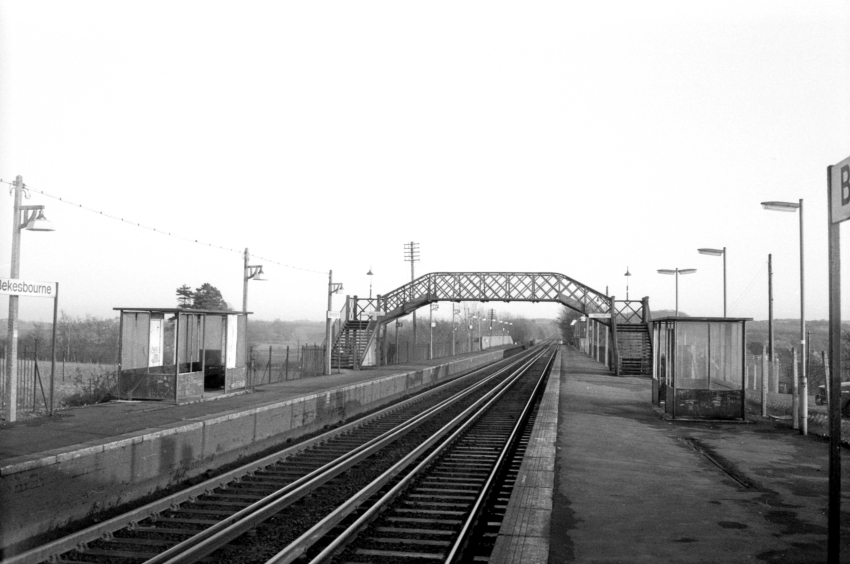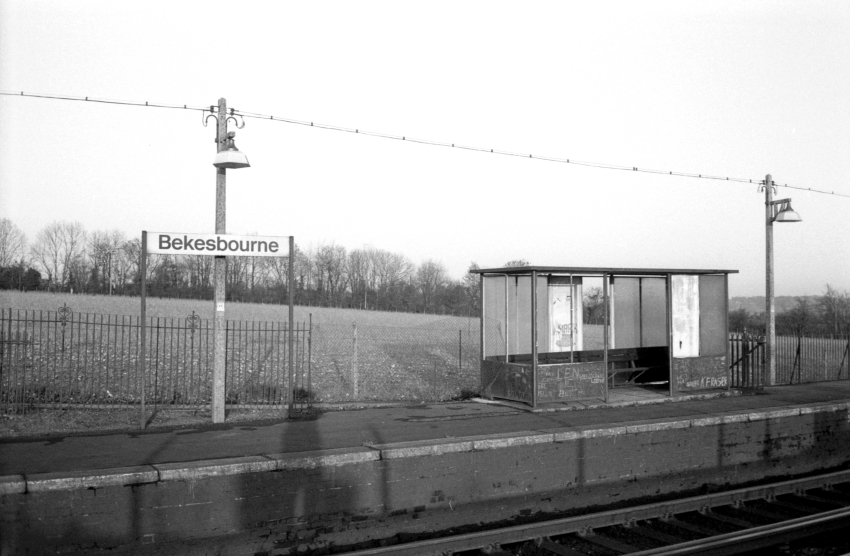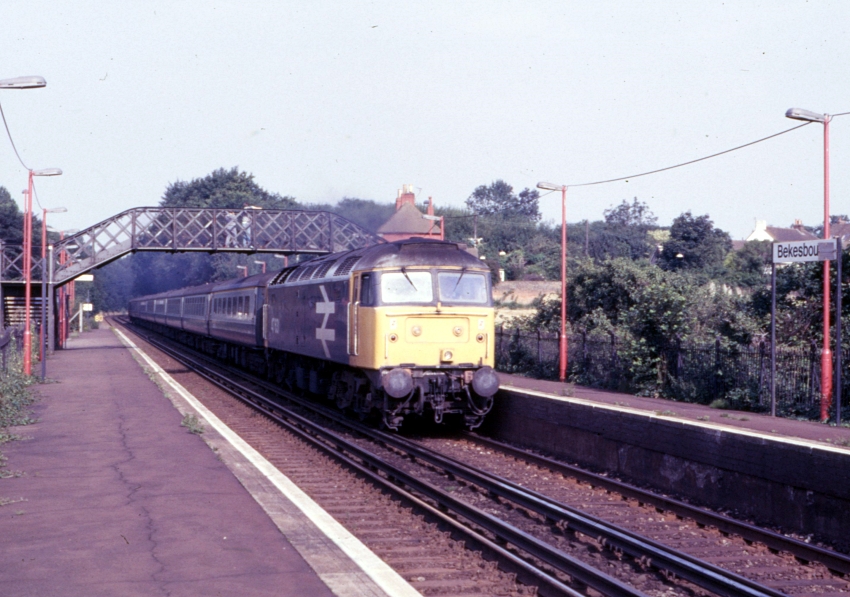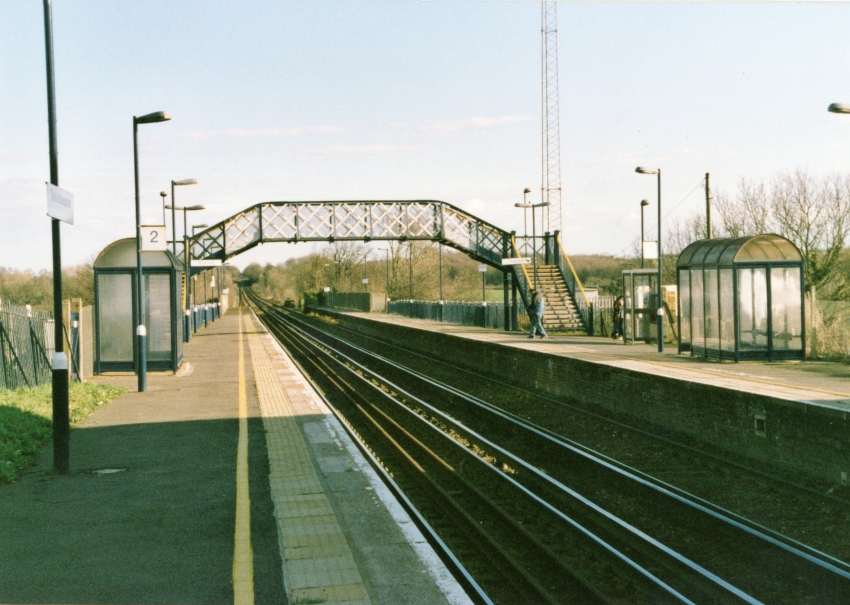Bekesbourne
In the October 1958 edition of The Railway Magazine, Bekesbourne was described as "a substantial country station, with brick buildings, including a goods shed, on the up side, and a footbridge to connect the down side, which has a simple wooden shelter only, as at Selling." Today, however, it is a very different scene at this station, situated 2-miles 73-chains from Canterbury East. A lattice footbridge is the only reminder of Bekesbourne’s halcyon days. Passengers today are merely afforded a pair of bus shelter-style structures — one on each platform — for protection against the elements.
The railway between Canterbury and Dover was engineered by Mr. Turner and the contractor was Mr. Crampton (ref: Jackson’s Oxford Journal, 27th July 1861). South east of Canterbury, a series of deep cuttings were excavated during the line’s construction. At about five o’clock in the evening on 28th January 1860, tragedy occurred in one of the cuttings at Bekesbourne: more than 100 tons of earth collapsed, which crushed three navvies (ref: The English Mail, 18th February 1860). The line was known as the Dover Extension and was 16-miles 6-furlongs in length, measured from Strond Street in Dover (south of Priory station and Harbour Tunnel) to a point five furlongs west of today’s Canterbury East station (ref: The Dover Chronicle and Kent and Sussex Advertiser, 27th July 1861).
The Dover Extension from Canterbury opened to public traffic on Monday, 22nd July 1861. In the 27th July 1861 edition of The Dover Chronicle and Kent and Sussex Advertiser, it was reported that Dover station (today's Dover Priory, then called Dover Town) was still incomplete and that the railway through Harbour Tunnel was laid and ended at a terminus still in the course of construction. The same publication also made mention of a station spelt Beakesbourne (possibly a typo of the time); however, there was no sign of this in the LC&DR’s July 1860 timetable published in the East Kent Gazette on 20th July 1860 — in fact, no intermediate stations between Canterbury and Dover were listed. Bekesbourne, Adisham, and Shepherd’s Well (two words and with apostrophe) were all present in the August 1860 timetable: each had five "down" weekday departures, four of which originated from Victoria and one from Canterbury. Additionally, there were four "up" departures, three of which were bound for Victoria — the fourth terminated at Canterbury.
As mentioned previously, this was a station that once boasted structures of generous proportions. Two platforms were situated either side of the double-track line, that on the "up" side being host to the main building. The latter was a variation of a standard LC&DR design used at intermediate stations on the route via Chatham and Canterbury. If the railway historian takes Shepherds Well’s still extant main building, adds a storey on top of the booking hall, the end result is virtually the original building erected at Bekesbourne. The "down" side was host to a rectangular-shaped timber waiting shelter, set upon a shallow brick base, built to the same design as that pictured on the Selling page.
On the "up" side of the line, west of the platforms, was situated the goods yard. A substantial brick-built goods shed was in evidence, the highest point of its pitched roof being as tall as the main station building. A single track entered and terminated within shed, and the 1877 Ordnance Survey edition shows that a wagon turntable was situated upon this siding, feeding a short stub positioned at a right angle to the rest of the yard. These features are illustrated on the accompanying 1873 diagram.
During the 1880s, a signal box opened at Bekesbourne, sandwiched in-between the main building and the goods shed on the "up" side of the station. This was a single-storey timber structure with a hipped slated roof that sat upon the platform surface. By the 1898 Ordnance Survey edition another siding, south of the goods shed, had been laid, its position being shown on the 1938 diagram.
1982

A Dover-bound view shows what the station was reduced to after staffing ceased in 1969. The main building formerly occupied the area on the right, marked by the metal lampposts. The platform extensions in the background and the concrete bracket lampposts date from 1958, in the run-up to electrification. The oldest structure in view is the lattice footbridge. © David Glasspool Collection
From the outset, passengers walked between the platforms on the level. By the 1907 Ordnance Survey edition, this was still the case; however, by the 1923 Railway Grouping, an attractive lattice footbridge linked both platforms, being situated on the Dover side of the station structures.
In 1913, Mr James Card became the Station Master at Bekesbourne, having originally joined the South Eastern Railway in 1879 as a telegraph clerk at London Bridge. Previously, he had been Station Master at West St Leonard’s, and at Lyminge before then. He died in the role at Bekesbourne at the age of 65 in April 1929, less than a month before reaching fifty years of railway service (ref: The Kentish Express, 4th May 1929).
Changes at Bekesbourne through the Southern Railway era appear to have been minimal, based on period photographs: concrete platform run-in nameboards were installed, but that appears to have been the limit. Even the diamond-shaped lamps upon the platforms seem to have avoided being replaced by the SR’s well-known Swan Neck type, although the latter were affixed to the footbridge.
Naturally, the British Railways era heralded a series of major changes at Bekesbourne. In summer 1958, the platforms were extended at their Dover ends using prefabricated concrete components, in preparation for the longer train formations that were due to be introduced with the accelerated electric timetable. At the same time, concrete bracket lampposts with hexagonal shades were installed along the lengths of both platforms. The withdrawal of public goods traffic from Bekesbourne was effective as of 5th June 1961 (ref: Clinker’s Register, 1980) — the yard’s entrance from the station’s forecourt had been protected by the same design of iron gates, emblazoned with SE&CR, which still exist along Harbour Road, Whitstable, and at the Elham Valley Line Trust museum at Peene, on the edge of Cheriton Shuttle Terminal (Folkestone). The signal box upon the platform was closed on 18th October 1964 (ref: Southern Railway Register, Section E1: St Mary Cray Junction to Dover Marine, Signalling Record Society), but the line between Faversham (exclusive) and Dover Priory retained traditional semaphore signalling after electrification in 1959.
1982

A vandalised shelter, devoid of its glazing, greeted passengers on the “down” platform. The iron railings along the platform’s rear edge dated back to the LC&DR era, having escaped being melted down during World War II. © David Glasspool Collection
Effective from 14th April 1969, Bekesbourne became unstaffed (ref: Clinker’s Register, 1980), and your author suspects that this is when all station structures — bar the footbridge and platform surfaces — were razed to the ground. Each platform became host to a rectangular waiting shelter, positioned on the Canterbury side of the footbridge, and the concrete bracket lampposts from 1958 were retained. Additional metal lampposts were installed in the space formerly occupied by the main building. By 1971, rumours began to circulate that the unstaffed station was being considered for closure; however, British Rail’s Area Manager confirmed at a Parish Council meeting in September of that year that this was not the case (ref: Kentish Express, 24th September 1971).
Your author’s observations of photographs of the site from summer 1988 show that the rectangular waiting shelters were still present and that the former goods yard site was without building development — the concrete lampposts had been replaced by metal types by summer of the previous year. Views of the station from 1989 show that the shelters installed at the time of rebuilding had been replaced by bus shelter-style types, the latter of which are shown in the February 2005 photograph on this page. By summer 1990, commercial redevelopment of the former goods yard site had been completed.
August 1987

Looking in the Canterbury direction from the "up" platform, Class 47 No. 47631 is seen bound for Dover Western Docks, likely from Liverpool Lime Street, with an InterCity CrossCountry service. The concrete bracket lampposts had gone, but the veteran footbridge remained. © David Glasspool Collection
What of the station today? Colour scheme and signage aside, Bekesbourne remains in its 1990 form, when the adjacent commercial development was completed. Given that the site had buildings more substantial than those still extant at Shepherds Well the station has, aesthetically, very much fallen on hard times.
12th February 2005

A Dover-bound view shows the glazed shelters that replaced the previous rectangular types in 1989. The station is situated 64-miles 58-chains from Victoria, upon a 1 in 132 gradient rising in the Faversham direction. © David Glasspool
Return to the Kent Rail Homepage or alternatively, check for Updates.
Website & Copyright information - Links - Contact the Webmaster


